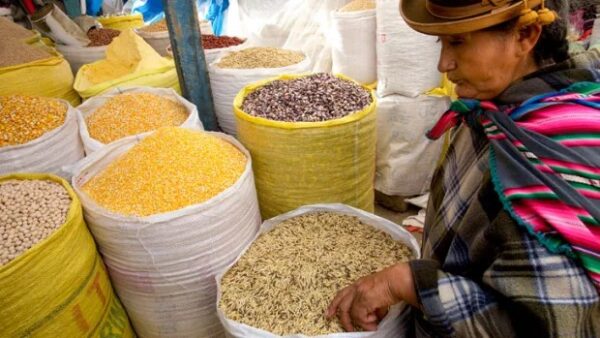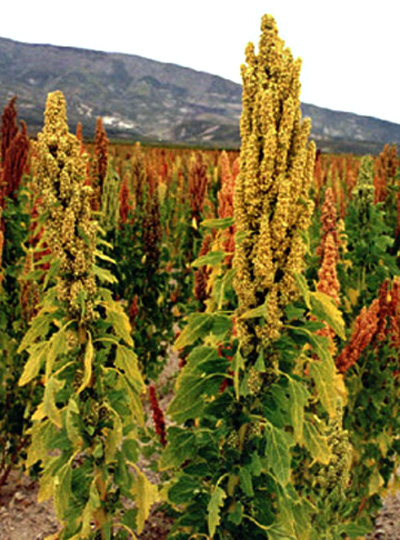This entry was originally part of the post titled Inka-dink-khipu because it was relevant to our bus ride from Ollantaytambo to Cusco. As I went through the process of creating shorter posts, this felt like the most natural point to place a break. However, since it bears no direct relation to the title of that post, rather than calling it part two, I gave it its own title.
What is the quinoa conundrum?
Our day of travel ended with our return to the Hotel Ruinas and my reunion with the eyeglasses I thought I’d lost on the bus from Puno several days earlier. Berner had approached me in the morning and showed me a photo on his phone asking, “Are these your glasses?” I’m not sure how everything transpired but at some point the bus company found the glasses and delivered them to the hotel.
After we checked in, Berner went off to spend the evening with his family and the three travelers arranged to meet for dinner after taking some time to freshen up. I’d asked Berner if he could recommend a place where I might try some pollo a la brasa and I must have misunderstood his directions because we couldn’t find it.
(My family and certainly any readers from the Testudo Times (TT) community are well acquainted with my – and many Marylanders’ passion for this Peruvian chicken dish that we lovingly call PC. The comments section in TT often veers from University of Maryland Athletics into a wide range of subjects. Periodically, PC – where best to find it outside of my neighborhood which is ground zero of sorts or who has the best rub or the best sauces or even the best side dishes – is a topic of discussion. I was determined not to leave Perú without measuring the authenticity of Maryland style against the real thing. I would get that chance in Lima. Twice.)
We did have to run a metaphorical gauntlet of the restaurant hawkers I mentioned in the post Because Cusco – part 2. One of them succeeded in getting us into his place on the promise of PC but, to my eyes, it lacked authenticity and we left without ordering. Instead, we returned for a second meal at Pucara.
As someone who eats no beef or other traditional western meat and only occasionally eats fish and fowl, I’d faced a bit of a protein dilemma since arriving in the Andes. The mountains are home to
quinoa – a so-called super food and an excellent source of plant protein (though not quite as excellent as the coca leaf). The dilemma was deciding how much quinoa I should eat.
Like the potato, quinoa has been cultivated in the Andes for thousands of years and, like the potato, it has many (100 plus) varieties. In the middle of the first decade of this century, the world – particularly the United States – ‘discovered’ quinoa. This was followed by a boom in demand that, quite predictably created a boom in price.
In a few short years, the subsistence food that urban Bolivians called comida de pobres (poor people’s food) or even more disparagingly rasguño de pollo (chicken scratch) and that farmers had sold in the year 2000 for as little as 2 soles (55 cents) per kilo could, by 2004, be sold for as much as 15 soles ($8) per kilo.
Suddenly, the highland farmers in Bolivia and Peru now earning significantly more income saw a future with more opportunity and comfort for themselves and their children. Some sent their children to university. Others bought new technology to increase their harvests or started to build new houses.
But some questioned if this opportunity for the farmers of the highlands presented unanticipated complexities. For example, would the new higher prices make quinoa less affordable to those urban poor who relied on it as an important dietary staple? Although the impact hasn’t been measured, prices at local markets increased from three soles per kilo to nine or ten for poor quality quinoa and to as much as 17 soles for good quality product.

[Photo of a local quinoa market from Sydney Morning Herald.]
Of course, as the market exploded, farmers in other parts of Perú and the world also saw an opportunity. Large-scale farmers along Peru’s coast with better access to irrigation and commercial fertilizers began replacing rice, asparagus, and other commodity crops with quinoa. By 2014, national quinoa production in Peru more than doubled from a reported 44,000 tons to slightly more than 114,000 tons. New coastal production accounted for more than 43,000 tons of the 70,000 ton increase. With the increased supply, the boom turned to bust and the price plunged to 4 soles per kilo. (Anecdotally, prices in 2019 have again increased.)
Interestingly, the governments of both Bolivia and Perú are each considering plans that would territorialize quinoa. The Bolivians are looking to create a designation of “Quinoa Real” applicable to a kind of quinoa produced exclusively in Southern Bolivia. In Perú, particularly in the region around Puno where one sees the highest production and consumption of quinoa, they are considering creating a collective brand that would differentiate quinoa grown in the Andes from quinoa grown elsewhere. Both of these efforts are akin to the Appellation d’origine Contrôlée used in France to protect champagne, various types of cheese, and other regionally specific agricultural products.
Hence, my dining dilemma. How often should I order quinoa? If I do so regularly, will it improve the lives of Andean farmers or will it compound the difficulties faced by the Andean urban poor? I tossed a coin. Heads for quinoa. Tails for something else. I ordered the ceviche mixto.
Tomorrow, Berner, Jan and I will hop on the short flight west to Lima while Jill begins her Amazon adventure with an even shorter flight east to Puerto Maldonado.
I hope you’ll join me in Lima.
